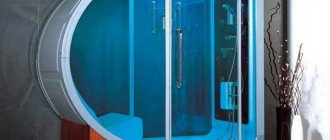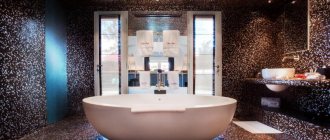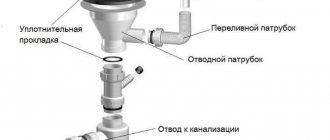Previously, people did not have to choose which radiator to install. Residents of the Soviet Union moved into a new apartment, where a coil built into the general heating system was already waiting for them. For years, this technical solution was used and served faithfully, until the assortment of plumbing stores appeared in many ways more convenient electric models.
So now homeowners face another serious question during renovations: how to choose a heated towel rail, water or electric, which is better? In this article we will try to sort out this issue and find the optimal solution for each apartment.
Varieties
There are two main types of heated towel rails:
- water
- electric
There are also combined ones, but they are used very rarely and, for the most part, due to their cost, are not particularly in demand in our market.
The tasks for both models are the same:
- Direct purpose is drying towels or other linen
- secondary - a heating radiator for a small room to create a comfortable temperature and coziness
If you don’t have a heated floor in your bathroom, then it’s not very pleasant in the winter to bring in a fan heater every time before taking a bath in order to raise the temperature to an acceptable level, and not get goosebumps.
- they also help prevent mirror fogging and condensation accumulation
A good heated towel rail should cope with all three of the above tasks.
general information
This product is a curved pipe, which is intended not only for drying clothes and towels (as the name suggests), but also acts as a means of heating. Thanks to this, you can avoid the appearance of fungus and mold on the walls of the bathroom. And, as you know, it is here that there is a fairly high level of humidity, which is a favorable environment for most pathogens.
On numerous forums you can find a lot of advice and reviews on which is better - a water or electric heated towel rail. And yet, it is not so easy to answer this question unequivocally. Both cases have their own characteristics. But no one will argue that both varieties help create a comfortable microclimate in the room. After finishing your water treatments in the shower, you don’t have to worry about “goose bumps” from the cold.
It is worth taking a responsible approach to choosing this product, taking into account such parameters as dimensions, power and material of manufacture. In this case, you can avoid the formation of condensation on the mirror and other surfaces, which is important for comfort.
Disadvantages of water heated towel rails
The very first models were only water type, so let's deal with them first.
The heat in them is radiated due to hot water circulating through the pipes. Without this hot spring, there will be no heat.
In older houses, this water was usually taken from central heating systems. Today, hot water pipes are mainly used.
The main popularity of this type of coil is its cost-effectiveness. This is the only thing for which he can be given at least some kind of plus.
Roughly speaking, you don’t pay anything extra for 24/7 operation. But if you connect an electric one, then your meter will count every extra kilowatt.
Apart from this dubious advantage, the water heater has nothing else to boast about. Then only the shortcomings and your headaches begin.
Firstly, you cannot regulate the temperature of the hot water supply in your apartment. You can only close the tap or open it.
But in electric ones, the level of adjustment is very wide. Everything will depend on the model you choose.
Secondly, it is location binding. Here you are very often limited to one wall and the level of the hot water pipes, namely the hot water riser.
Therefore, it is not always possible to fit them into a beautiful design exactly the way you would like.
On the other hand, the electric unit can be located in any place where there is a nearby outlet, taking into account, of course, wet areas and no closer than 60 cm from the water intake point.
Pressure
In order for a heated towel rail to serve faithfully for a long time, appropriate conditions are required. The operating pressure in the DHW system should be in the range of 0.3-6 atm. Regarding centralized heating, the indicators here are slightly different and largely depend on the area of residence. As a rule, in multi-story buildings the pressure does not exceed 10-12 atm.
As those who choose between water or electric heated towel rails can understand, this applies more to the first type. With the latter, everything is a little easier.
Causes of leaks
The third drawback is leaks. According to statistics, it is these water dryers in the bathroom that are the most common cause of flooding for neighbors below.
Why does this happen and how can it be avoided? When installing water heated towel rails, the human factor plays the most important role. Not its novelty and quality, but precisely the installation moments and the level of the installer.
Somewhere, not enough sealing material was added to the threads or the gasket was skewed. Somewhere a nut was not tightened. All this eventually leads to a small leak.
Moreover, the joints are usually masked and covered with false walls, or recessed into them. As a result, you won’t even notice this leak.
Water will gradually accumulate behind the tiles and at one point all this beauty will simply fall off the wall.
Here's a scary video of what really happens to the neighbors below when a pipe breaks on a water heated towel rail under pressure of several atmospheres.
Saving on cheap fittings and craftsmen ends up costing millions in months of repairs. After this, people immediately switch to electric alternatives.
And if your installation was done by a truly professional and the product itself is branded, can you be 100% sure that there will be no leaks and you won’t flood anyone? No again!
This is where the fourth factor comes into play - the quality of hot water. If it is too “aggressive” and contains a large number of chemically active components, then in a year or two, such a liquid will corrode the thin walls at the threaded connections.
Only daily monitoring, inlet filtration and timely purchase of new spare parts or the entire dryer will help here.
Maximum temperature
This parameter is also of great importance and should not be ignored. The temperature in the hot water supply system usually does not exceed 60 °C, and as for heating, there is rarely a figure above 80 °C. In this regard, all stainless steel products are the best choice, since they are designed for a maximum temperature of 105-110 °C.
However, it is not always possible to avoid emergency situations when the supplied water can be heated to hundreds of degrees, if not more. Therefore, it is necessary to make a choice with reserve.
No water - no heat
The fifth significant drawback is interruptions in the supply of hot water. They occur at least once a year, but in practice this happens much more often.
Even if you have a private house with a gas heating boiler, then there is no point in having a water heated towel rail. Few people would think of running a boiler in the summer because of one small coil. It is cheaper to adapt a boiler for this purpose.
The sixth problem, on the contrary, is related to not turning off the water. If in the summer heat the hot water is not turned off, and your coil has a decent area and is connected directly without valves, such a thing can raise the temperature in a small bathroom over 40 degrees!
On the contrary, we will have to wrap up the pipes and somehow plug up this extra heat source.
Seventh, periodic water outages, in addition to inconvenience, lead to more serious consequences. The metal from which the heated towel rail is made heats up and contracts depending on its temperature.
The same thing happens with all threaded connections. And the more often your hot water is turned off, the sooner you expect a leak.
And if you have metal-polypropylene joints, then due to different expansion coefficients, you will see a leak even earlier.
In addition, models of complex shapes have a large number of welds. And they are also a potential site of damage.
Combined option
We can say that this is a universal solution. Such heated towel rails use hot water as the main coolant, and electricity serves as an additional alternative. And if in the region of residence there are periodic interruptions in water supply (and it does not matter whether it is only hot water or heating) and electricity, then the choice between combined, water and electric heated towel rails leans more towards the first option.
To a greater extent, this is justified by the fact that such devices include two heating circuits. Moreover, they are located in such a way that they do not depend on each other. This makes it possible to use them in turn.
This symbiosis of water and electric types combines the advantages of both types in one product. If there is hot water (or heating), then the heated towel rail acts as a water pipe, and in its absence, an electrical reserve is connected. As a result, functionality is increased and energy consumption is reduced to a minimum.
Choosing an electric heated towel rail
Modern electric heated towel rails are very energy efficient devices and consume 40-60W of power.
This is even smaller than a conventional incandescent light bulb. Not to mention the 200W or halogen “heaters”, which, if desired, can be used to assemble a full-fledged infrared stove.
True, such low power is inherent in the minimum mode, which only copes well with drying towels.
At the bottom of some specimens there is a built-in regulator, which can be used to increase the load several times in steps.
For example, in medium mode at 60-80W, it will no longer be possible to hold your hand on the handsets for a long time.
Meanwhile, huge units that almost cover the entire wall can reach up to 2 kW.
By the way, in order to fully heat the bathroom with these dryers, when purchasing, remember that the optimal thermal conditions of the room are ensured only if there is about 100 W of thermal energy per 1 m2.
Therefore, for a standard bathroom, an economical model up to 100W will only cope well with socks and underwear. Don't expect miracles from her.
For noticeable heating, choose models with a power of up to 600W, with the ability to adjust and reduce the load.
Of course, no one is forcing you to run the dryer 24 hours a day. If in winter this is completely and rationally, then in summer it can be turned on only after taking a shower or bath in order to dry the room, laundry and other things.
Release form
For some, shape is no less important, especially in situations where you want to give your bathroom a distinct personality. And today, in order to decide which heated towel rail is better - water or electric in terms of appearance, there are all possible options:
- Ladders are the most common models, which are completely practical in terms of operation: they heat the room and you can dry a lot of things.
- Ladder with a shelf - everything is the same here, but with one difference - there is a shelf on top. Both convenience and practicality in one product - you can not only keep your towels clean, but also save space.
- Letter E - here neatness borders on simplicity, and the products do not take up much space.
- The letter U is simple, stylish, concise. At the same time, such a pipe will not allow many things to dry due to its design.
- Letter M - thanks to its shape, the heated towel rail allows you to place much more laundry than the above analogues.
- Snake is the most popular shape of curved pipes with a rather attractive design. You can also dry a lot of things on it.
Thanks to this choice, there will be no problems with choosing a dryer for the bathroom (and one that matches the bathroom interior).
Connecting an electric heated towel rail
A very important point for electric models is the correct connection to the 220V network. They should only “sit down” on the line with the RCD and be sure to be grounded.
Grounding in most models is connected in the same place as the power wires.
This does not spoil the appearance and design, but at the same time provides protection.
For this reason, make sure that the plug and socket have the appropriate grounding contacts.
Even if a washing machine produces an electric current, what can we say about a metal thing with an electric cable or heating element running inside it.
In the event of an insulation breakdown and the absence of normal differential protection with a grounding loop, it will be a potential killer, patiently waiting for the moment when you deign to throw a damp towel over it with wet hands.
By the way, grounding pipes is a prerequisite for plumbing devices. Firstly, it helps against corrosion. Secondly, a water coil, just like a water tap, can give you an electric shock, even if the leak is not in your apartment, but in your neighbors.
Read more about this in the article below.
Installation
It’s up to you to choose an electric or water heated towel rail, but it’s worth saying a few words about installing this battery. Before you start changing the coil, call a plumber. He will tell you in detail what diameter is needed and what distance should be between the pipe inlet and outlet.
Next, go to the store and buy a heated towel rail of your choice, and then call the plumber again, this time to install the coil. Even if you're an ambitious person and think you can replace your heated towel rail yourself, think twice before doing it. It is unlikely that you want to subsequently make repairs to the neighbors below.
The housing office must be notified in advance about changing the heated towel rail so that the water can be turned off while the dryer is being replaced (a paid service). Also warn your neighbors, because... Installing a heated towel rail can take up to several hours.
The best material of manufacture is steel or copper
When you have decided on the type of heated towel rail, it’s time to think about what material it should be made of.
All water coils are made from the following materials:
- stainless steel
- black protected steel
- non-ferrous metals – copper or brass
To understand which one is better, let's look at the features of each separately.
Stainless steel models can be installed in almost any bathroom, but they are very vulnerable to foreign impurities in the water itself.
Stainless steel pipes can be:
- painted
- polished
- chrome plated
Painted, the cheapest and most affordable. However, they lose their presentation very quickly.
Everyone needs a durable device, which is why they usually choose chrome-plated options.
Models for which black steel is used are coated on the inside with a protective compound that prevents the development of corrosion on the walls. Externally, they are no different from stainless steel coils.
Heated towel rails made of copper or brass have the highest heat output. However, their durability leaves much to be desired.
These models, although beautiful, are less functional.
Cost and popular models
Consumers will find electric and water dryers in specialized stores. The following models are very popular:
- "Sunerja Elegy" . Electric heated towel rail Surnezha coil is made of stainless steel. The chrome coating makes it possible to install the product in different interiors. The model has the appearance of a three-dimensional ladder, the choice of shades is wide. The cost depends on the size of the device, varies from 16,000 to 24,400 rubles.
- "Galant" is a modern water heated towel rail made of ladder-shaped. The model is equipped with a top shelf. The connection can be vertical or standard (side). Heat transfer level 182 – 494 W. The cost ranges from 5900 rubles to 9500 rubles, it depends on the size of the product.
- "Fashion M" . This is a water coil made from stainless steel. The shape of the product is M-shaped, the pipe diameter is 25 mm. Small models with a size of 320x400 mm cost from 2900 rubles. The price for larger coils reaches 3,500 rubles.
- "Terminus Europe" . The heat output of this water-type model is at the level of 295 W, and stainless steel is used for manufacturing. The jumpers are located on the right and left, due to this the heated towel rail has an original appearance. The connection is bottom, the Mayevsky tap is built into the product.
- "Energy U-G3" . This is a reliable electric heated towel rail. Its distinctive feature is the presence of three U-shaped rotating sections. They can be rotated 180°. The product has a network indicator, the cost of the coil is 12,200 rubles.
In stores you can find other high-quality models from domestic and foreign manufacturers.











